|
|
|
Sort Order |
|
|
|
Items / Page
|
|
|
|
|
|
|
| Srl | Item |
| 1 |
ID:
126371
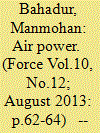

|
|
|
|
|
| Publication |
2012.
|
| Summary/Abstract |
The Indian Air Force (IAF) is into its eighth decade and as it closes in on its centenary, a mere two decades away, many a treatise has been propounded on the challenges ahead for the youngest armed service of independent India. What started as a mere flight of Wapitis at Drigh Road, Karachi, has grown into a potent power projection arm of the state.
The IAF derives its fortitude from its motto, Nabha Sparsham Deeptam (Touch the Sky with Glory). But there is perhaps a limitation in the coining of this motto as there is a hint of conclusiveness in the envelope of operation of Air Power. A more intuitive and farsighted approach may well have resulted in its coining to include space, the final frontier. But is space the final frontier? One better be careful lest a scribe writing about the IAF a few decades from now also questions this writer's perceptive ability!
Limiting the horizon to a manageable timeframe makes the future 'realistically' transparent. So, considering a timespan of 20 years, when the IAF turns 100, let's evaluate how the anticipated threats and challenges are to be addressed based on the IAF doctrine.
|
|
|
|
|
|
|
|
|
|
|
|
|
|
|
|
| 2 |
ID:
126468


|
|
|
|
|
| Publication |
2012.
|
| Summary/Abstract |
Boeing has a long history in India, beginning with its 707 commercial jetliner that was acquired by Air India in 1960. The wait for successful military orders took much longer, but Boeing has done its homework well to come out on top for important contracts for the Indian Air Force (IAF) and Indian Navy (IN). Importantly for Boeing, the orders all have the potential for repeat orders, ensuring that Boeing will be busy well into the next decade. Boeing's success in the Indian market is also a huge opportunity for Indian aerospace and software companies as Boeing purchases goods and services from more than 23,000 suppliers across the world worth more than USD 50 billion each year. The company's global supply chain contributes more than 60 per cent of the value of its products. Boeing delivered 601 commercial airplanes and supported the delivery of 144 production military aircraft in 2012!
|
|
|
|
|
|
|
|
|
|
|
|
|
|
|
|
| 3 |
ID:
126461


|
|
|
|
|
| Publication |
2012.
|
| Summary/Abstract |
Over the last six years Clarion Events has built up Defence & Security Equipment International (DSEI) to become the world's largest fully integrated defence and security exhibition. Over that period, global spend on defence and security has fluctuated; however, nations such as India have found themselves on the positive side of this change. With the Indian aerospace defence industry being one of the fastest growing in the world, this has attracted major global aerospace companies to India and the reason why events like DSEI have become so important, as companies around the world adapt to the changing environment and look towards new markets to trade and build business ties.
|
|
|
|
|
|
|
|
|
|
|
|
|
|
|
|
| 4 |
ID:
126465
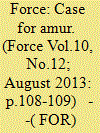

|
|
|
|
|
| Publication |
2012.
|
| Summary/Abstract |
St Petersburg: In India, warnings are seldom taken seriously. Even disasters that follow the warnings are usually accepted with a sense of philosophical fatalism. So, for whatever it is worth, here is a warning from the Rubin Design Bureau of Russia which has designed the Kilo class submarines, 10 of which the Indian Navy operates: Two Indian submarines are past their service life and the third one is quickly on the way. Anything can happen to these boats and the responsibility will be of the Indian Navy.
|
|
|
|
|
|
|
|
|
|
|
|
|
|
|
|
| 5 |
ID:
126118
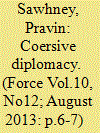

|
|
|
|
|
| Publication |
2013.
|
| Summary/Abstract |
In an unexpected development, a Chinese border guards' platoon (30 soldiers) moved in and pitched tents 19 kilometres inside Indian territory at Depsang Valley overlooking Daulet Beg Oldie (DBO) on 15 April 2013 in Ladakh in the Western sector. The last time they did a similar thing was in 1986 in Sumdorong Chu in the Eastern sector (Arunachal Pradesh). Both times, the Chinese forces had blessings from the highest quarters: then supremo Deng Xiaoping and now the President and chairman of the Central Military Commission, Xi Jinping. Then, the Chinese were not a risen power and the occupation of Sumdorong Chu, of little tactical significance, was meant to test Indian gumption, through military coercion, after the passing away of Prime Minister Indira Gandhi, who Deng admired for being a strong and determined leader. There was a year-long stand-off with menacing military build-up on both sides ending in a mutually agreed disengagement with neither side looking a loser. The Chinese finally left Sumdorong Chu of own free accord in 1995. China's military coercion had not worked for two reasons: India showed political will, and China's military capability did not match its coercion.
|
|
|
|
|
|
|
|
|
|
|
|
|
|
|
|
| 6 |
ID:
126378
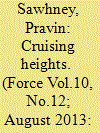

|
|
|
|
|
| Publication |
2012.
|
| Summary/Abstract |
Two news items regarding the DRDO long-range cruise missile mission need to be flagged. First, in a rare admission by a DRDO chief, M. Natarajan, days before his retirement on 1 September 2009, said that, "The lack of success in developing indigenous propulsion systems for the country's major programmes is a cause of concern. Affected are programmes such as the aero engines for fighter aircraft and unmanned aerial vehicles, engines for tanks and naval propulsion and ramjet and hypersonic propulsion for missiles."
|
|
|
|
|
|
|
|
|
|
|
|
|
|
|
|
| 7 |
ID:
126167
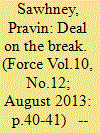

|
|
|
|
|
| Publication |
2013.
|
| Summary/Abstract |
US vice-president Joe Biden, on his recent visit to India, expressed optimism on ironing out the problems in setting-up of US civil nuclear reactors in Gujarat, and putting bilateral strategic relations on track. He knows well that both issues are interconnected, and India's nuclear liability law is not the singular hurdle in the way of the high-end commercial deal. India, especially Prime Minister Manmohan Singh, who had invested much more than his political capital in the civil nuclear deal, has lost heart. India, under his watch, has committed itself to no nuclear testing without signing the Comprehensive Test Ban Treaty.
|
|
|
|
|
|
|
|
|
|
|
|
|
|
|
|
| 8 |
ID:
126441
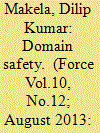

|
|
|
|
|
| Publication |
2012.
|
| Summary/Abstract |
The stage for the cyber war has already been set, albeit secretly. In the last two months, the revelations made by the US' ex-Central Intelligence Agency employee, Edward Snowden, in various interviews to The Guardian newspaper, revealed that the US' intelligence organisation, National Security Agency (which had launched the top-secret PRISM programme) was snooping on personal data of individuals and governments in the US and across the world through the internet. He also revealed that the National Security Agency (NSA) intercepted a big chunk of sensitive information that belongs to India by spying on the embassies and their diplomatic missions. And perhaps the most daunting revelation was that the information sharing between the intelligence agencies of various countries, such as the US and the UK, is already underway.
|
|
|
|
|
|
|
|
|
|
|
|
|
|
|
|
| 9 |
ID:
126381
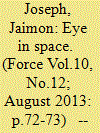

|
|
|
|
|
| Publication |
2012.
|
| Summary/Abstract |
Normally, it takes 20-32 seconds for a state-of-the-art GPS/GLONASS receiver to get a lock on satellites and plot location co-ordinates. Dr Vyasaraj Guru Rao, a specialist with 17 years of experience in Global Navigation Satellite System (GNSS) navigation technologies has proposed a method by means of which one is able to obtain position in eight seconds, which he says can be adopted as a part of the Indian Regional Navigation Satellite system (IRNSS) programme.
|
|
|
|
|
|
|
|
|
|
|
|
|
|
|
|
| 10 |
ID:
126373
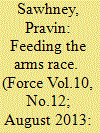

|
|
|
|
|
| Publication |
2012.
|
| Summary/Abstract |
In numerous interviews meant to mark his presence, the new Defence Research and Development Organisation (DRDO) head, Avinash Chander, has said that in his three-year term, he intends to induct both the Agni-4 (3,000km) and Agni-5 (5,000km) ballistic missiles into service. He will also place Agni-6 with 6,000km (not yet sanctioned by the government) on track for its first test-firing in 2017. The importance of Agni-6, according to him, is that it would carry Multiple Independently Targetable Re-entry Vehicles (MIRVs), which each warhead striking a different target.
|
|
|
|
|
|
|
|
|
|
|
|
|
|
|
|
| 11 |
ID:
126216
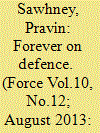

|
|
|
|
|
| Publication |
2013.
|
| Summary/Abstract |
It was a masterstroke by the Pakistan Army 10 years ago. The cue, probably, came from the blockbuster Bollywood movie, Baazigar (gambler), where the hero believed that to gain something big, you have to lose something. By offering the ceasefire on the Line of Control (LC) on 24 November 2003, the Pakistan Army gained a windfall in return for peanuts: it sacrificed covering fire to infiltration across the LC. In return, it got a tamed Indian Army which fenced itself on the LC sending the unambiguous signal that its offensive thinking of the Nineties had been put aside. Docility became the mind-set of the Indian Army and all that is wrong with this wonderful organisation today followed.
|
|
|
|
|
|
|
|
|
|
|
|
|
|
|
|
| 12 |
ID:
126122
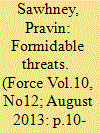

|
|
|
|
|
| Publication |
2013.
|
| Summary/Abstract |
China does not need to go to war with India. Pakistan, at present, is satisfied with its strategy of proxy war against India. However, a limited two-front war into the future started by Pakistan in Northern Kashmir (Siachen) is not ruled out; Chinese involvement in it will be indirect with its asymmetrical capabilities. India's political and military leadership, unfortunately, has shown little appreciation of what it may be up against.
China accomplished the incredible by its three-week intrusion in April 2013 in Northern Ladakh against India. With mere 30 border guards, it did successful military coercion resulting in a total capitulation of India's political leadership. This showed a lack of understanding in Delhi of Chinese diplomacy where counter-coercion does not necessarily translate into war. Moreover, China which is pitted against the US for supremacy in Asia would stay away from a border war with India. However, its coercive diplomacy, especially one achieved with minimal show of strength, has provided numerous strategic gains to Beijing.
|
|
|
|
|
|
|
|
|
|
|
|
|
|
|
|
| 13 |
ID:
126419
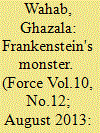

|
|
|
|
|
| Publication |
2012.
|
| Summary/Abstract |
Sometimes imagination can be as dangerous as lack of it. In 2005, the state Congress leader in Chhattisgarh, Mahendra Karma was struck by what he must have thought a masterstroke: Pitting people against people. This would accrue multiple benefits, for him personally and for the BJP-run state government.
|
|
|
|
|
|
|
|
|
|
|
|
|
|
|
|
| 14 |
ID:
126462


|
|
|
|
|
| Publication |
2012.
|
| Summary/Abstract |
Consummate performer. Entertaining raconteur. Master of deflection. The deputy director general of Rosoboronexport, Victor M. Komardin is all of this and much more. To start with, he has to be a very successful salesman, to have retained his job for 13 years. In a country like Russia, where appointments and dismissals are at the pleasure of the executive, Komardin's achievement is no mean feat and deserves applause even from the most ungenerous and sceptical journalists.
|
|
|
|
|
|
|
|
|
|
|
|
|
|
|
|
| 15 |
ID:
126162
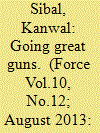

|
|
|
|
|
| Publication |
2013.
|
| Summary/Abstract |
In the last decade the biggest change in the complexion of our foreign relations has been with the US. The general attitude in India has become markedly positive towards the US. In return, bi-partisan support now exists in the US for enhanced ties with India, expressed at times with much rhetoric.
|
|
|
|
|
|
|
|
|
|
|
|
|
|
|
|
| 16 |
ID:
126435
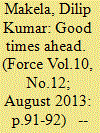

|
|
|
|
|
| Publication |
2012.
|
| Summary/Abstract |
The BrahMos cruise missile is one of the biggest success stories that Indian defence industry has managed to produce till date. It has been developed as a joint venture between India's Defence Research and Development Organisation (DRDO) and Russia's Federal State Unitary Enterprise NPO Mashinostroyenia (NPOM) under BrahMos Aerospace.
|
|
|
|
|
|
|
|
|
|
|
|
|
|
|
|
| 17 |
ID:
126147
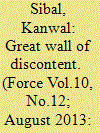

|
|
|
|
|
| Publication |
2013.
|
| Summary/Abstract |
Our relationship with China in the last decade shows features of tensions, mistrust and lack of a solution to some underlying problems coupled with efforts to build confidence, engagement and progress in some areas. In other words, the quality of the relationship has remained largely unchanged. Ties today would be probably a shade worse than they were a decade ago.
|
|
|
|
|
|
|
|
|
|
|
|
|
|
|
|
| 18 |
ID:
126469
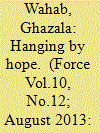

|
|
|
|
|
| Publication |
2012.
|
| Summary/Abstract |
New Delhi: Atlas Elektronik's plans in India seem to have hit a speed breaker called the Hindu rate of growth. While there is potential and promise, the movement is inordinately slow and the answers are hard to come by. So effectively, the India office of Atlas, launched with much optimism a few months ago, is currently doing spot-running, with several programmes in various stages of 'expression of interest', 'request of information', request for proposal', 'technical discussions' and so on. While it is difficult to sustain optimism in such trying circumstances, Atlas Elektronik India Pvt Ltd is manned by a group of seasoned professionals who have dug themselves in for a long haul. "We are here for a long time," says CEO, Atlas Elektronik India Pvt Ltd, Khalil Rahman matter-of-factly. "We have to look beyond prevalent pessimism," he adds for good measure.
|
|
|
|
|
|
|
|
|
|
|
|
|
|
|
|
| 19 |
ID:
126464
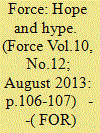

|
|
|
|
|
| Publication |
2012.
|
| Summary/Abstract |
St Petersburg: The Russian ship-building industry is in an interesting position vis-a-vis India, these days. It has unparalleled history of cooperation with the Indian services. It professes to extend support and technology that no other country can do. And it has been sanguine in the knowledge that the user (Indian Navy) and its political masters have a degree of comfort when it comes to their products and platforms.
|
|
|
|
|
|
|
|
|
|
|
|
|
|
|
|
| 20 |
ID:
126372
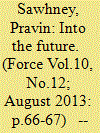

|
|
|
|
|
| Publication |
2012.
|
| Summary/Abstract |
The new Defence Research and Development Organisation (DRDO) chief Avinash Chander has recently said that phase-I of the indigenous ballistic missile defence (BMD) programme is over and the missile shield is ready for the protection of New Delhi, the capital of India. Phase I is for interception of 2,000km range enemy missiles, and phase II for killing 5,000km range missiles. This implies that the BMD technology demonstrator phase is over and the DRDO would ask for additional massive funds to deploy the actual weapon system. This spectacular news has reached China and Pakistan; Chinese scholars are comparing it with their own indigenous BMD programme and Pakistan would use this to further justify increased production of more ballistic and cruise missiles, and fissile material.
|
|
|
|
|
|
|
|
|
|
|
|
|
|
|
|
|
|
|
|
|